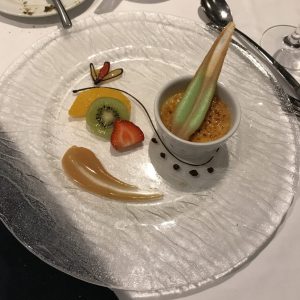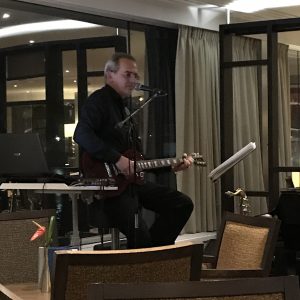Sunday evening, May 7, 2017
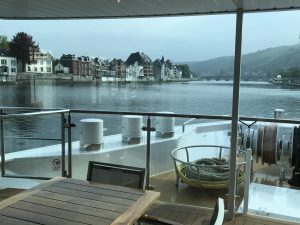 Avalon Waterways makes their boarding process so easy. Our previous cruise was on Holland America Line with 1,950 passengers boarding. The Avalon Luminary holds a maximum of 138 passengers. On this cruise, there were only about 85 passengers.
Avalon Waterways makes their boarding process so easy. Our previous cruise was on Holland America Line with 1,950 passengers boarding. The Avalon Luminary holds a maximum of 138 passengers. On this cruise, there were only about 85 passengers.
After getting our room keys and dropping our bags, we met in the lounge for the introductory meeting and champagne toast. Each of the managers was introduced and said a few words about his or her department. After raising our glasses, we adjourned to the dining room for our first dinner together.
This is the ideal place to tell you what meals were like on Avalon Waterways: They were wonderful! Each dish was carefully prepared and beautifully presented. Each item on the menu was marked for possible allergens and veggie/vegan preferences. And the wait staff? Delightful, thoughtful, friendly, attentive to each diner’s wants and needs.Breakfast included standard breakfast buffet items, but also had three fresh-cooked items on the menu. Sometimes there was Eggs Benedict, sometimes waffles (real Belgian waffles!). Omelets were always available, along with cheeses, dried fruits, dry cereal, housemade yogurt and kefir. A smoothie-of-the-day. Fresh-from-the-comb honey. Coffee, tea, orange juice and champagne. Wonderful fresh-baked breads. On and on. If you went away hungry, you had no one to blame but yourself.
Lunches included a salad bar and a prepared sandwich, two soups, several buffet items—including vegetables, meats, and starches—but also a carving station, “Daily Live Cooking with your Head Chef.” There were usually two small desserts, and sometimes ice cream and toppings were available.
Dinner was a four-course wonder. Fresh breads with a spread and an herbed butter arrived with our complementary beverages. The first course included appetizers and salads. One evening it was a Dutch cucumber cocktail, an Angus beef fillet carpaccio, and a chef’s salad with green beans, cherry tomatoes, olives, and honey sesame vinaigrette. This was followed by our choice of two soups, frequently a cream soup and a broth. There were four choices of entrees, always including a seafood choice and a vegetarian/vegan choice. And of course a few desserts were offered, along with coffee and tea. Presentation was stunning; the kitchen staff who plated all these choices were artists.
Happy hour, with live music, occurred each evening an hour before dinner, and after dinner the musician would play again, stepping up the tempo to satisfy those travelers who wanted to dance.
And at the back of the ship was a lounge where freshly baked cookies were always available, along with coffees, tea, and juices. If you got hungry on this cruise, it was your own fault!
One of the best parts of the trip for me began after dinner on Sunday evening. We went back into the bar to continue our socializing. There were only a handful of people there with us, and the musician was playing. At the end of one song I went up to him and introduced myself, telling him I was the opera accompanist at my local university and that I had lots of piano bar experience, and asked if I could play along with him on a piece. That was the beginning of a beautiful relationship!Each afternoon or evening for the rest of the trip Valentin and I played four or five pieces together. Toward the end of the week, I even bought him a couple songs off MusicNotes, songs that were unfamiliar to him but favorites of mine. He quickly learned them and added them to his repertoire. People started recognizing me and asking when I would play again. Even the hotel manager thanked me for playing and told me how much he enjoyed hearing Valentin’s and my playing together. The final morning, as we were waiting to leave the ship, I sat and played solo for half an hour to help the time pass more quickly for the other passengers.
I’m usually reluctant to ask to play anyone’s piano. Having been on the receiving end of such requests, one just never knows what’s going to come out of someone else’s fingers. But this. Oh my gosh, this was a musical match made in heaven. [Patting self on back for having the courage to approach Valentin.] We’ve already talked about getting together next year to repeat the experience. Now if I can just convince my travel companions to schedule another cruise to coincide with Valentin’s schedule.
Monday, May 8, 2017
A panoramic view of the Meuse river. On the left, you can see where the Sambre joins the Meuse.
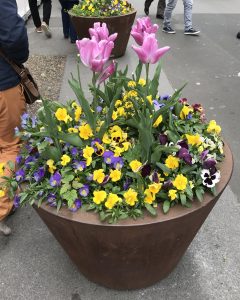 While still in port in Namur, we had the opportunity to explore the town with a local guide. We boarded a coach and went first up to the hill overlooking the town to visit the Citadel. The Citadel dates from 937 A.D. and is situated at the confluence of the Sambre and Meuse rivers. The Meuse would be our path for several days of our cruise. We spent 45 minutes or so walking around the fortress, ending with the opportunity to visit a parfumerie that is located there. I wanted each of the watercolors that were framed and hanging on the walls of the perfume showroom.
While still in port in Namur, we had the opportunity to explore the town with a local guide. We boarded a coach and went first up to the hill overlooking the town to visit the Citadel. The Citadel dates from 937 A.D. and is situated at the confluence of the Sambre and Meuse rivers. The Meuse would be our path for several days of our cruise. We spent 45 minutes or so walking around the fortress, ending with the opportunity to visit a parfumerie that is located there. I wanted each of the watercolors that were framed and hanging on the walls of the perfume showroom.
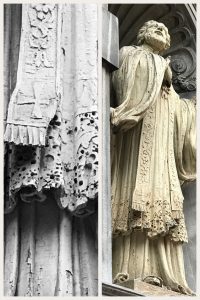 Back on board the coach, we rode steep and curvy roads I would never want to drive, back down to the boat, where we began our walk about the old town. I was delighted with the sculptures inside and outside L’église Saint-Loup (the Church of Saint Lupus). I will never comprehend how sculptors can translate marble into fabric. Stunning!
Back on board the coach, we rode steep and curvy roads I would never want to drive, back down to the boat, where we began our walk about the old town. I was delighted with the sculptures inside and outside L’église Saint-Loup (the Church of Saint Lupus). I will never comprehend how sculptors can translate marble into fabric. Stunning!
The website OpenChurches says about this Catholic church:
This church, admired by the poet Charles Baudelaire, is perhaps considered as one of the most beautiful 17th century Baroque buildings in Belgium. It is based on the church of Jesus in Rome. As it is situated in a narrow pedestrian street, one cannot distance oneself from it but even so the blue stone facade in three superimposed sequences can be admired.
Inside it is the vault on powerful columns which attracts attention: a sumptuous sculpted décor in yellow and ochre stone, the tufa from around Maastricht.
The church has been richly decorated over the centuries with an evident taste for coloured marble. In this way the Jesuits wanted to glorify God. Part of the furnishings has been removed and another part has either been restored or is in the process of being so. Thus the 10 confessionals which date from the 17th and 18th centuries have been brought back, some framed by chubby or rascally cherubs and others with plant patterns. Noteworthy also are the pulpit, communion table and baptismal fonts.
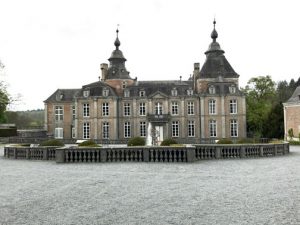 After walking around the town some more, we headed back to the boat for lunch, and then got on the coach again for a ride to Le Château de Modave, also known as Le Château des Comtes de Marchin (Château of the Counts of Marchin) near the town of Modave in the province of Liege. The château is said to be most prominent preserved example of High Baroque country-house architecture in the Southern Netherlands. The château is routinely closed on Mondays, but they opened for us, so we were able to have the guide to ourselves and be able to easily hear what she said and ask questions about the beautiful interiors. There are many pictures of the château in the gallery at the bottom of the page.
After walking around the town some more, we headed back to the boat for lunch, and then got on the coach again for a ride to Le Château de Modave, also known as Le Château des Comtes de Marchin (Château of the Counts of Marchin) near the town of Modave in the province of Liege. The château is said to be most prominent preserved example of High Baroque country-house architecture in the Southern Netherlands. The château is routinely closed on Mondays, but they opened for us, so we were able to have the guide to ourselves and be able to easily hear what she said and ask questions about the beautiful interiors. There are many pictures of the château in the gallery at the bottom of the page.
A few of the items in the chateau that delighted me: The table and silver service in the dining room were lavish. There were over 1,000 pieces in the service, and the castle name was printed by the manufacturer on the back of each piece. The guide told us that dining rooms didn’t exist in homes in the Middle Ages. There was no silverware – only knives. In the Duchess’s bedroom, the 60-light crystal chandelier was made by Baccarat. The bathrooms were advanced for their time. The house is located in the Houyeux River valley, and was constructed 60 metres higher than the water.
The piano was beautiful. I was dying to touch a few notes to see how it had held up to time. Henri Herz was a French pianist who became interested in making pianos. He obtained a patent in 1843 for a grand piano with the sounding board above the strings. He died in 1888, and his widow entered the last Herz pianos in the Paris exhibition of 1889, where they won a gold medal.
Seeing a magnificent home like this – or like the Biltmore Estate closer to home – makes you wonder what it was like to live in a place like that. The cost of maintaining and staffing a residence like that must have been sobering.
After the house tour, we headed back toward the boat, stopping first for a beer tasting at La Roseraie Restaurant in Modave. The chef-owner had constructed a tasting room on the property in back of the house. White canvas, vinyl windows, lots of plants, and wrought iron, cushioned seating made for a very pleasant, light-filled room in which to enjoy hors d’oeuvres and Belgian beers. The lawns and gardens of the property were beautifully manicured and landscaped with shrubs and flowers that delighted my eyes. As we arrived, Chef Vignon was picking violas to use as a garnish on the appetizers he had prepared.
The chef had put together this feast at the request of Avalon Waterways when they began cruising this area. The fare he put together and the quantity and presentation of the food was stunning. There were three Belgian beers, along with a lesson in what to look for in a beer. He told us in Belgium you select your beer, then the waiter asks what you’ll have to go with that. Clever.
We left and drove back to the boat, which was now moored in Huy, further up the Meuse. We boarded and the crew immediately cast off to take us to our next stop, Maastricht. Another wonderful dinner, and a number of locks to experience. More cocktails, wine, and music.
We’re loving this river cruise experience.



